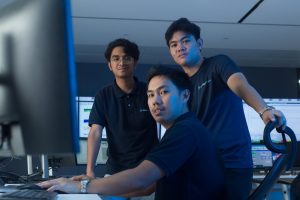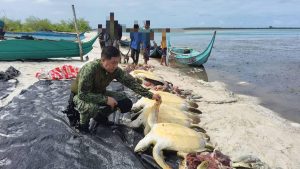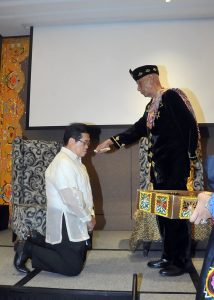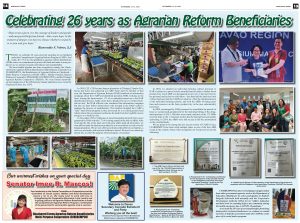DAVAO CITY (MindaNews) — Mercy Muhamad, 44, dismounts from the rusty bicycle’s sidecar even before her husband has come to a full stop. This the fourth dumpsite for them, with three more to go before calling it a day.
She is already rummaging through the heap of rubbish when her husband Abdul Muhamad (“13 years older than me,” she laughs) joins in. The couple works with surgical precision, instinctively knowing which plastic bag contains salvageable material to be sold at the junk shop.
For the past seven years, this has been their livelihood. But today– just like in the past three months — both are wearing a cloth mask.
Although cloth masks, designed using cut fabric, are not as effective compared to medical masks, they have the added advantage of being reused multiple times. The Department of Health has recommended that they should be washed with warm water and soap every day.
Since they are reusable, they do not end up in waste bins, unlike surgical masks.
In the past few weeks, Mercy has picked the habit of holding a stick, its brown membrane blackened by grime and grease, instead of her bare hands.
“I carry this around with me just in case,” she says, as she holds up the stick at the garbage collection point along Padre Gomez St. Not long after, she uses it to poke a soiled medical mask out of the way.
“I see them regularly nowadays,” she adds. “On average, I can find 15 to 20 of them every day.”
To demonstrate, she stands from her crouched stance then proceeds to count nine discarded medical masks. And those are only what she spots from her position. There are still plenty of them stuffed inside plastic bags and cardboard boxes.
The couple hails from Cotabato City and when her husband lost his job seven years ago, they hopped on a bus for the six-hour ride to Davao City for better opportunities. With the help of relatives, they rented a small space in the slums near the Sta. Ana wharf and have lived there since.
The COVID-19 pandemic has disrupted their livelihood like no other. She says they earned 400 to 500 pesos (10 USD) before the lockdown, but now they consider it a good day if they can bring home 300 pesos (6 USD).
When Mayor Sara Duterte announced a lockdown in mid-March, the couple and their two children — aged 6 and 18 — had to stay home, fully dependent on the food aid from the city government as the economy crawled to a standstill.
But they can’t stay holed out forever as expenses are piling up and school enrollment is approaching fast. When the city shifted from Enhanced Community Quarantine to General Community Quarantine on May 16, the couple went back to work.
“I didn’t want to go out because it is scary,” she says. “When I see a (medical) mask, I become paranoid. What if I get infected by the virus?”
No worries?
Dr. Lenny Joy Rivera, assistant regional director of the Department of Health in Davao Region, allayed fears that face masks pose health hazards since ordinary people do not have sustained contact with COVID-19 positive patients.
Frontline healthcare workers, on the other hand, must be equipped with complete personal protective equipment (PPE) to minimize the risk of getting infected with the virus since they have sustained exposure and close contact with patients, infected liquid, plasma, and other materials.
But Rivera agreed that households need to learn how to properly manage used medical masks, face shields, and gloves. For instance, separating them into a designated container, disinfecting it before dumping it on site would drastically minimize health risks.
“We will discuss that with the city, as well as the provinces, to release some guidelines for them to be aware of what to do and also avoid a community scare,” she says. “Because they might be unnecessarily alarmed when they see a mask somewhere.”
Davao City tops Mindanao in terms of COVID-19 cases. As of 5 p.m. on June 29, the Davao Center for Health Development recorded 411 cases with 301 recoveries and 28 deaths in Davao City out of the Davao region’s 529 cases, 356 recoveries and 32 deaths.
At least eight barangays in the city have been categorized as “very high-risk” and five others as “high risk” areas and people have been warned against going to these areas from June 27 to July 5 due to the high incidence of localized transmission.
Designated COVID-19 facility
The state-owned Southern Philippines Medical Center (SPMC) has been identified as the lone designated COVID-19 treatment facility in Davao. As of June 29, it had accepted 426 positives, 306 of whom recovered – with median age of 37 — while 33 died, with median age of 52.
The SMPC is a participant in the global solidarity trial to determine the efficacy of potential drugs to combat SARS-CoV-2, the virus that causes COVID-19.
On the average, according to Dr. Leopoldo Vega, SPMC chief until his designation early this month as Health Undersecretary, each healthcare frontliner is given 25 sets of PPE as they attend to the patients. For patients classified as moderate, the assigned health worker is given 10 to 15 PPEs. For those treating patients with mild symptoms, they are provided five PPEs each.
The hospital management is asking donations while also ramping up its procurement process to meet the demand.
But how does SPMC dispose of the PPE waste to prevent cross-contamination?
Dr. Ricardo B. Audan, Chief of Professional Services at SPMC and concurrent OIC SPMC chief, said the facility is equipped with an autoclave and incinerator but these are not being used for COVID-19 wastes. Instead, they outsource it to a third-party company to dispose of the soiled PPEs.
“Before we give the soiled PPE, we have a protocol on that. We put it in a plastic bag, disinfect and seal it before we place it in our garbage bin,” he reveals. “There is a designated place where the outsource company picks up that soiled PPE.” (To be continued)
(Joel Escovilla for MindaNews. Escovilla is Associate Editor of Mindanao Times in Davao City. The production of this special report was made possible with support from Internews’ Earth Journalism Network) TOMORROW: Pyroclave
1st of three parts





